

Assignment 11:
Polar Equations
by
Wenjing Li
1. Investigate
![]()
Note:
* When a and b are equal, and k is an integer, this is one textbook version of the " n-leaf rose."
* Compare with
![]()
for various k. What if . . . cos( ) is replaced with sin( )?
1. Let a and b be equal. For a=1, b=1 and k is an integer k=1, the graph looks like an one-leaf rose.

For a=1, b=1, and k=2, we get the graph which is a two-leaf rose, the two leaves are symmetric with respect to the y-axis and each leaf is symmetric with respect to the x-axis. The graph passes the points (2,0) and (-2,0).
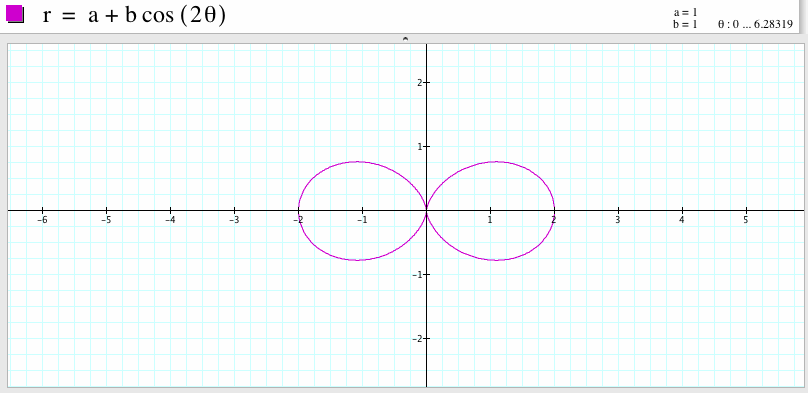
For a=1, b=1, and k=3, we get the graph which is a three-leaf rose, the graph is symmetric with respect to the x-axis. One leaf passes the point (2,0) and the other two leaves pass the points (0,1) and (0,-1) respectively.
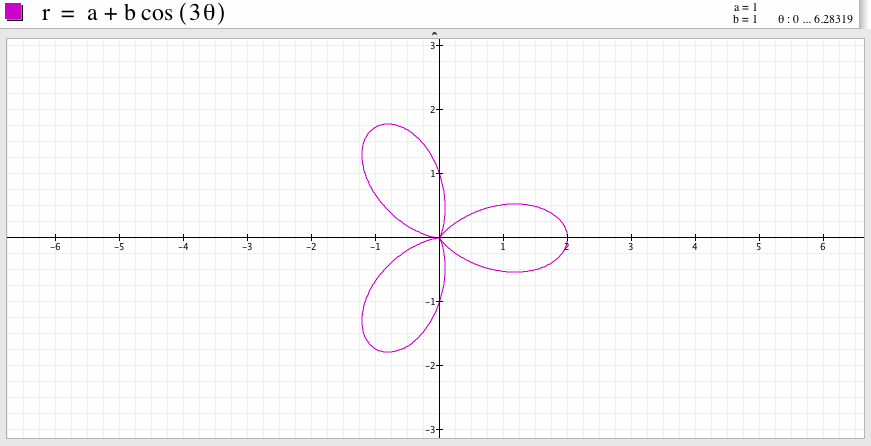
For a=1, b=1, and k=4, we get the graph which is a four-leaf rose, the graph is symmetric with respect to the y-axis and is also symmetric with respect to the x-axis. The graph passes the points (2,0), (-2,0), (0,2) and (0, -2).
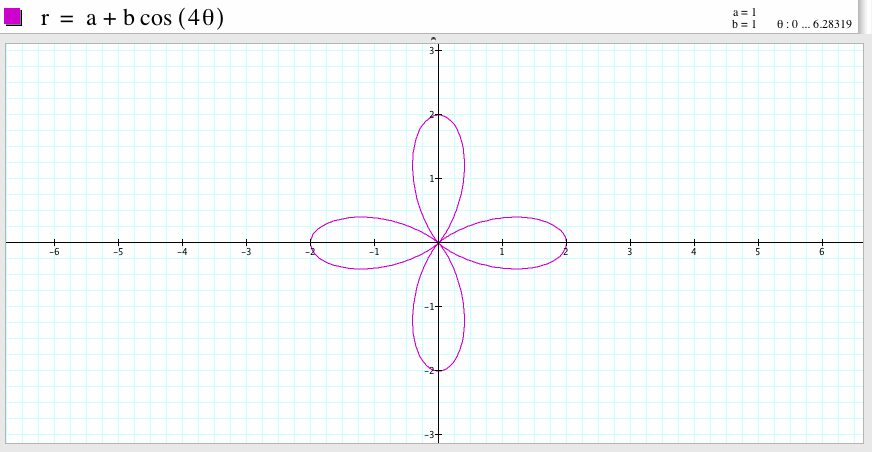
For a=1, b=1, and k=5, we get the graph which is a five-leaf rose, the graph is symmetric with respect to the x-axis. One leaf passes the point (2,0) and two leaves pass the points (0,1) and (0,-1) respectively.
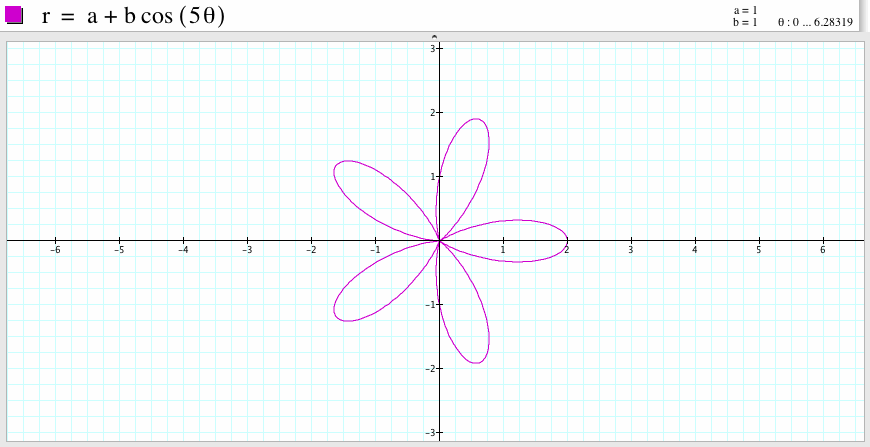
In general, if a and b are equal and k is an positive integer, the graph of the polar equation ![]() is a k-leaf rose which is symmetric with respect to the horizontal x-axis. There is always one leaf on the positive direction of the horizontal x-axis. If k is even, then the graph is symmetric with respect to the y-axis and is also symmetric with respect to the x-axis. If k is odd, the graph is symmetric with respect to the x-axis.
is a k-leaf rose which is symmetric with respect to the horizontal x-axis. There is always one leaf on the positive direction of the horizontal x-axis. If k is even, then the graph is symmetric with respect to the y-axis and is also symmetric with respect to the x-axis. If k is odd, the graph is symmetric with respect to the x-axis.
2. Let us compare with the graph of the polar equation
![]()
If b=1, and k=1, then the graph is a circle passes through the point (0,0) and (1,0) and has diameter 1.
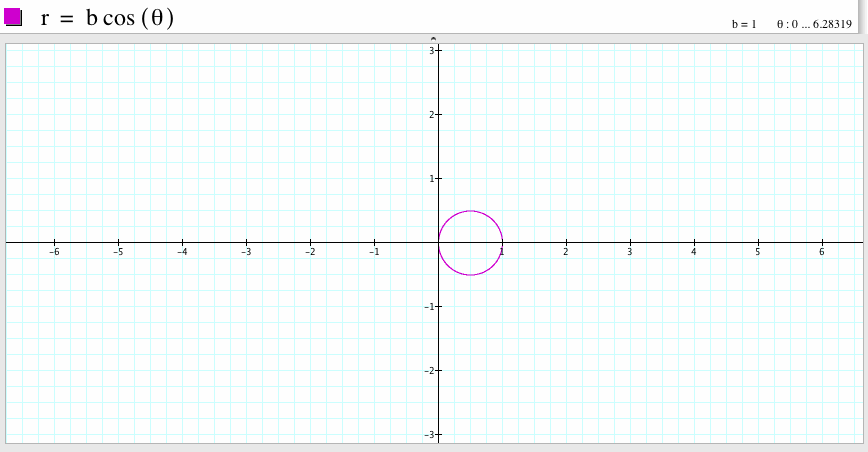
If b=1 and k=2, then the graph is a four-leaf rose. The graph is symmetric with respect to the y-axis and is also symmetric with respect to the x-axis. The graph passes the points (1,0), (-1,0), (0,1) and (0, -1).
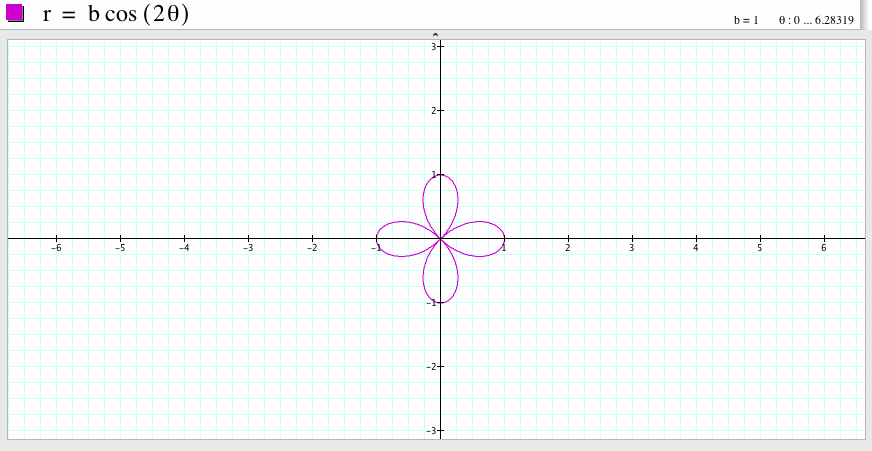
If b=1 and k=3, we get the graph which is a three-leaf rose, the graph is symmetric with respect to the x-axis. One leaf passes the point (1,0).
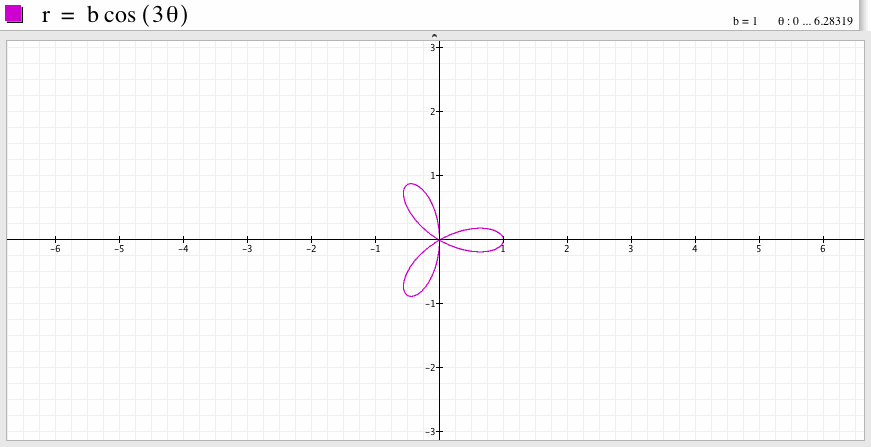
If b=1 and k=4, then the graph is a eight-leaf rose. The graph is symmetric with respect to the y-axis and is also symmetric with respect to the x-axis. The graph passes the points (1,0), (-1,0), (0,1) and (0, -1).
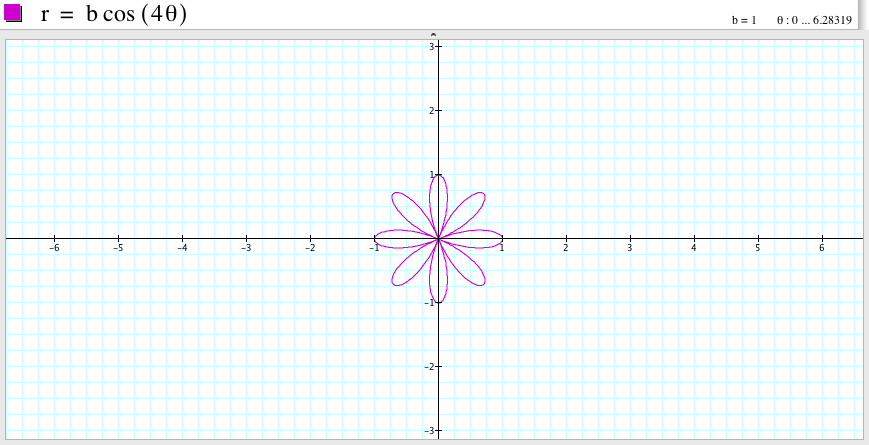
If b=1 and k=5, we get the graph which is a five-leaf rose, the graph is symmetric with respect to the x-axis. One leaf passes the point (1,0).
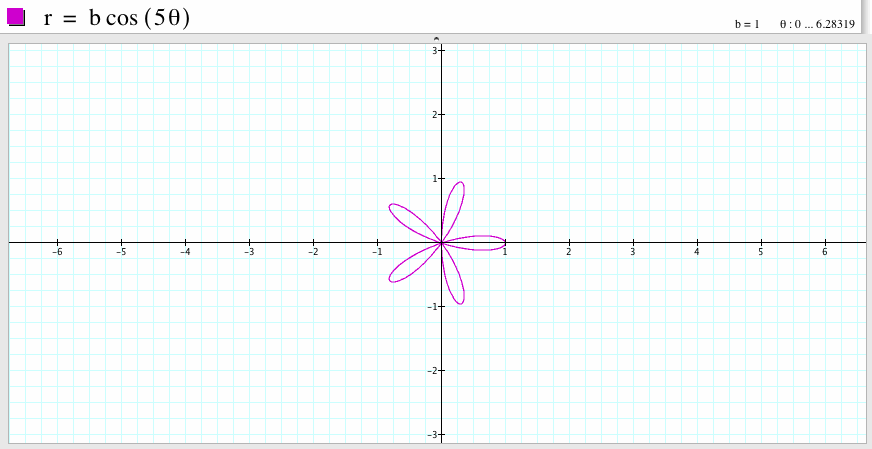
To summarize, if k is odd, then the graph of the polar equation ![]() is a k-leaf rose which is symmetric with respect to the horizontal x-axis. There is always one leaf on the positive direction of the horizontal x-axis. It is similar to the graph of the polar equation
is a k-leaf rose which is symmetric with respect to the horizontal x-axis. There is always one leaf on the positive direction of the horizontal x-axis. It is similar to the graph of the polar equation
![]()
which is also a k-leaf rose. If k is even, then the graph of the polar equation
![]()
is a 2k-leaf rose. If k is even, the graph of the polar equation
![]()
will have two times the number of leaves compare to the graph of the polar equation
![]()
3. Now let us investigate what will happen if we replace cos( ) with sin( ).
1. Let a and b be equal. For a=1, b=1 and k is an integer k=1, the graph of the polar equation
![]()
looks like an one-leaf rose. It passes through points (0,2), (1,0), (-1,0). Compare to the graph of the polar equation
![]()
if we rotate it 90 degree angle, we will get the graph of the polar equation
![]()
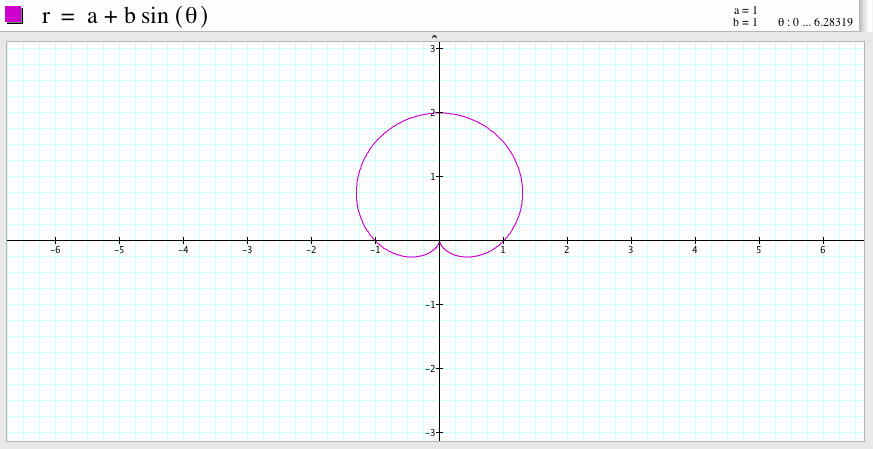
For a=1, b=1, and k=2, we get the graph which is a two-leaf rose, the two leaves are symmetric with respect to the line x=-y. The graph passes the points (1,0), (-1,0), (0, 1) (0, -1). Compare to the graph of the polar equation
![]()
if we rotate it 45 degree angle, the shape looks like the graph of the polar equation
![]()
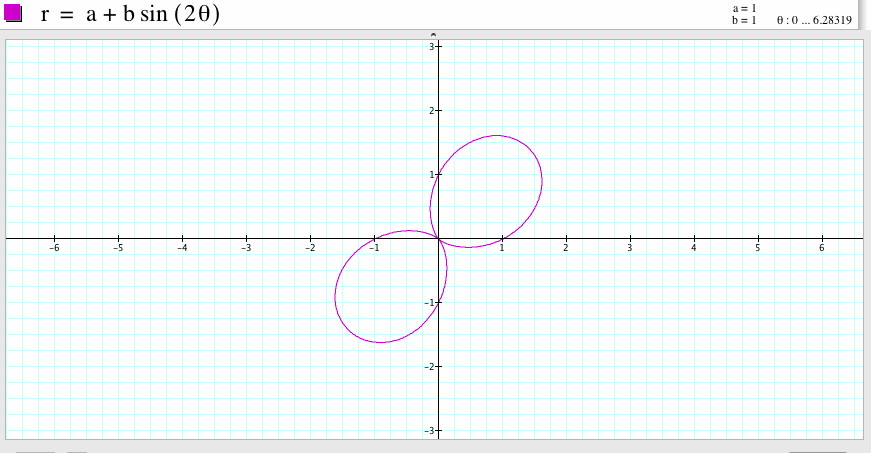
For a=1, b=1, and k=3, we get the graph which is a three-leaf rose, the graph is symmetric with respect to the y-axis. One leaf passes the point (0,-2) and the other two leaves pass the points (1,0) and (-1,0) respectively. Compare to the graph of the polar equation
![]()
if we rotate it 90 degree angle, the shape looks like the graph of the polar equation
![]()
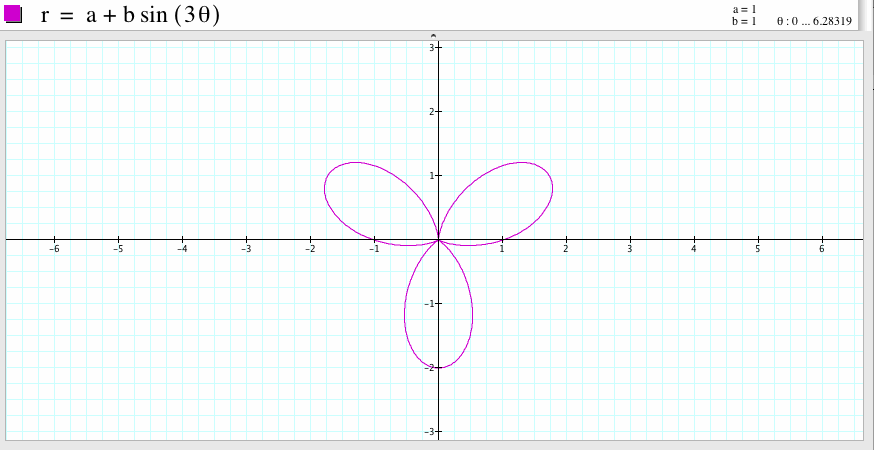
For a=1, b=1, and k=4, we get the graph which is a four-leaf rose. The graph passes the points (1,0), (-1,0), (0,1) and (0, -1). Compare to the graph of the polar equation
![]()
if we rotate it for a certain angle, the shape looks like the graph of the polar equation
![]()
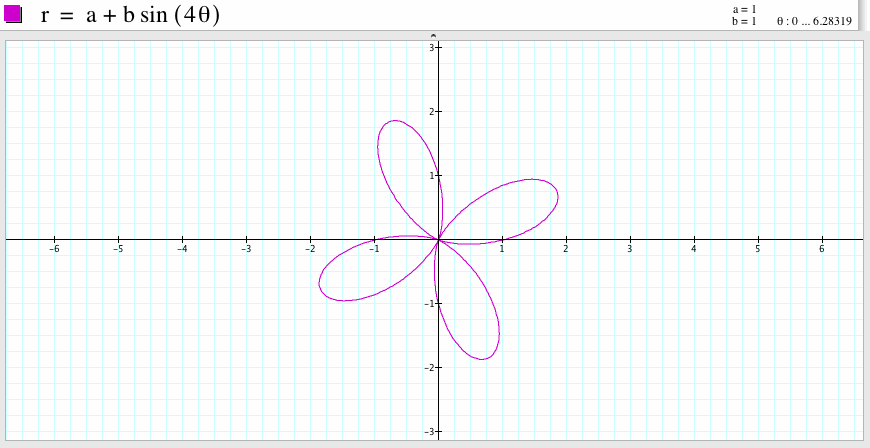
In general, if a and b are equal and k is an positive integer, the graph of the polar equation
![]()
is a k-leaf rose. Compare to the graph of the polar equation
![]()
if we rotate it for a certain angle, the shape looks like the graph of the polar equation
![]()
4. Let us compare with the graph of the polar equation
![]()
If b=1, and k=1, then the graph is a circle passes through the point (0,0) and (0,1) and has diameter 1.

If b=1 and k=2, then the graph is a four-leaf rose. The graph is symmetric with respect to the y-axis and is also symmetric with respect to the x-axis. Compare to the graph of the polar equation
![]()
if we rotate it 45 degree angle, the shape looks like the graph of the polar equation
![]()
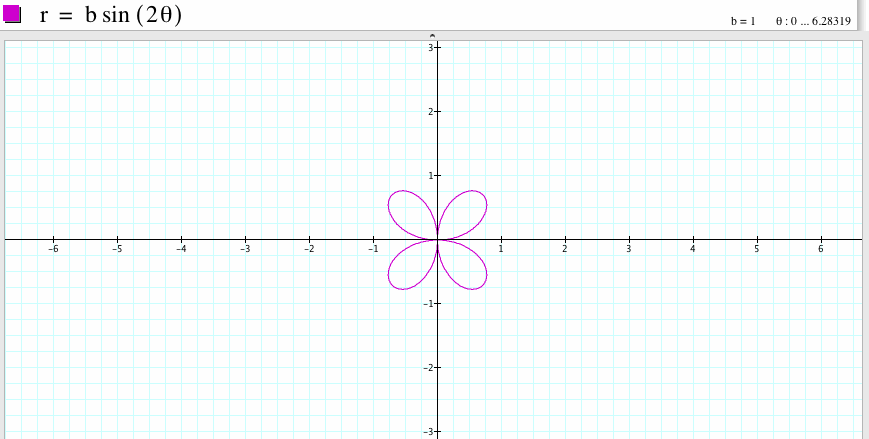
If b=1 and k=3, we get the graph which is a three-leaf rose, the graph is symmetric with respect to the y-axis. One leaf passes the point (0,-1). Compare to the graph of the polar equation
![]()
if we rotate it 90 degree angle, the shape looks like the graph of the polar equation
![]()
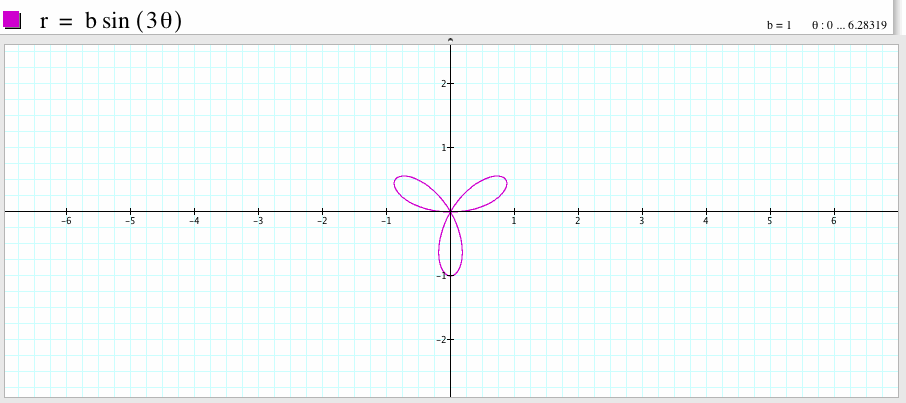
If b=1 and k=4, then the graph is a eight-leaf rose. The graph is symmetric with respect to the y-axis and is also symmetric with respect to the x-axis. Compare to the graph of the polar equation
![]()
if we rotate it for a certain angle, the shape looks like the graph of the polar equation
![]()
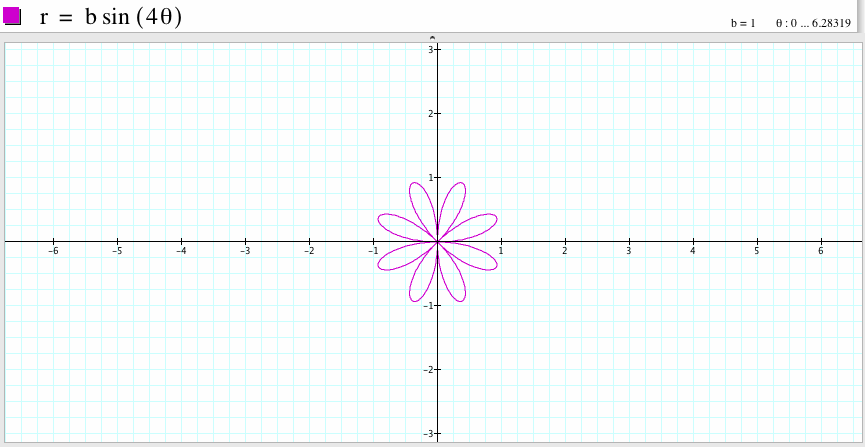
To summarize, if k is odd, then the graph of the polar equation
![]()
is a k-leaf rose. It is similar to the graph of the polar equation
![]()
which is also a k-leaf rose. If k is even, then the graph of the polar equation
![]()
is a 2k-leaf rose. If k is even, the graph of the polar equation
![]()
will have two times the number of leaves compare to the graph of the polar equation
![]()
Compare to the graph of the polar equation ![]() , if we rotate it for a certain angle, the shape looks like the graph of the polar equation
, if we rotate it for a certain angle, the shape looks like the graph of the polar equation
![]()